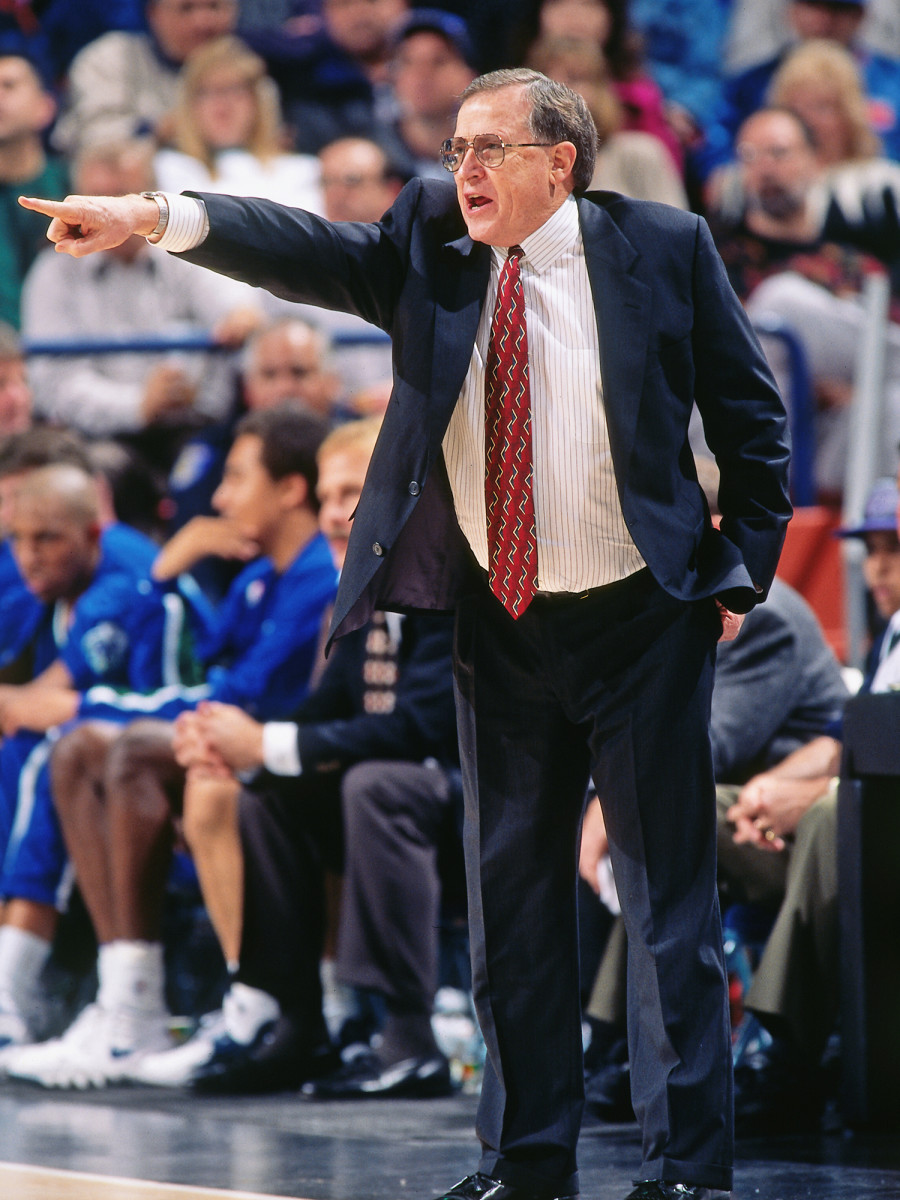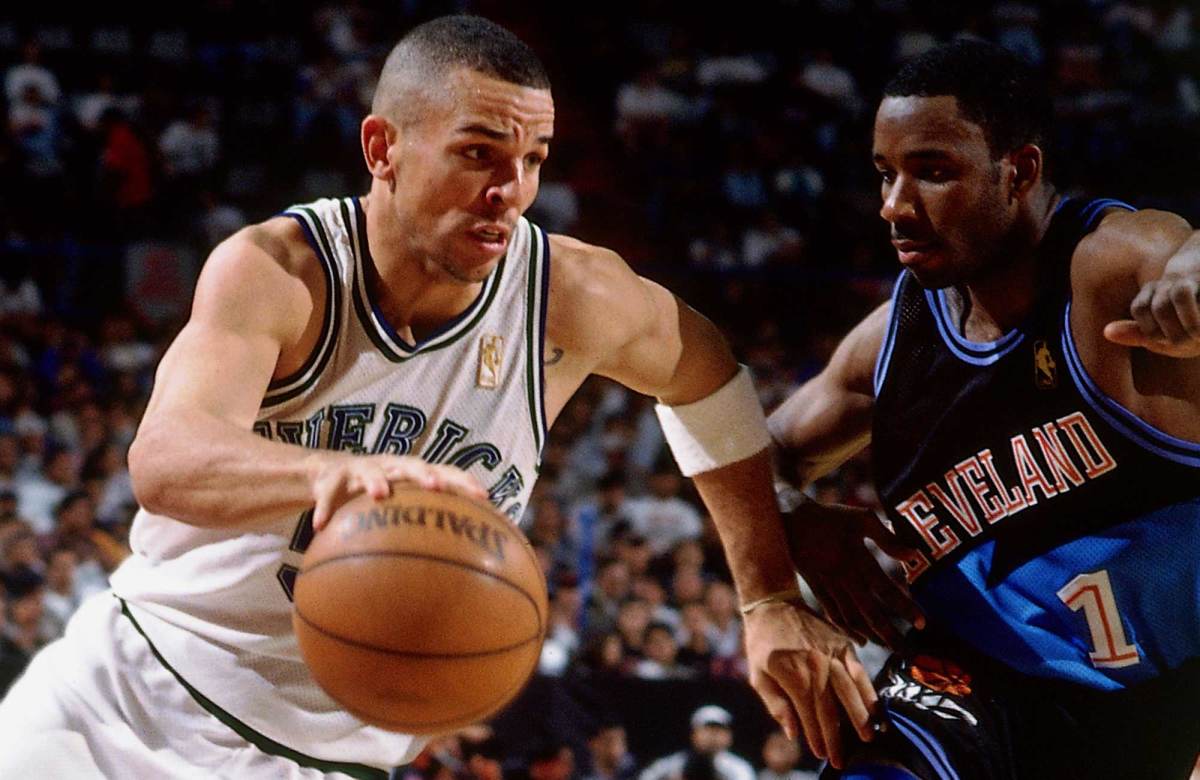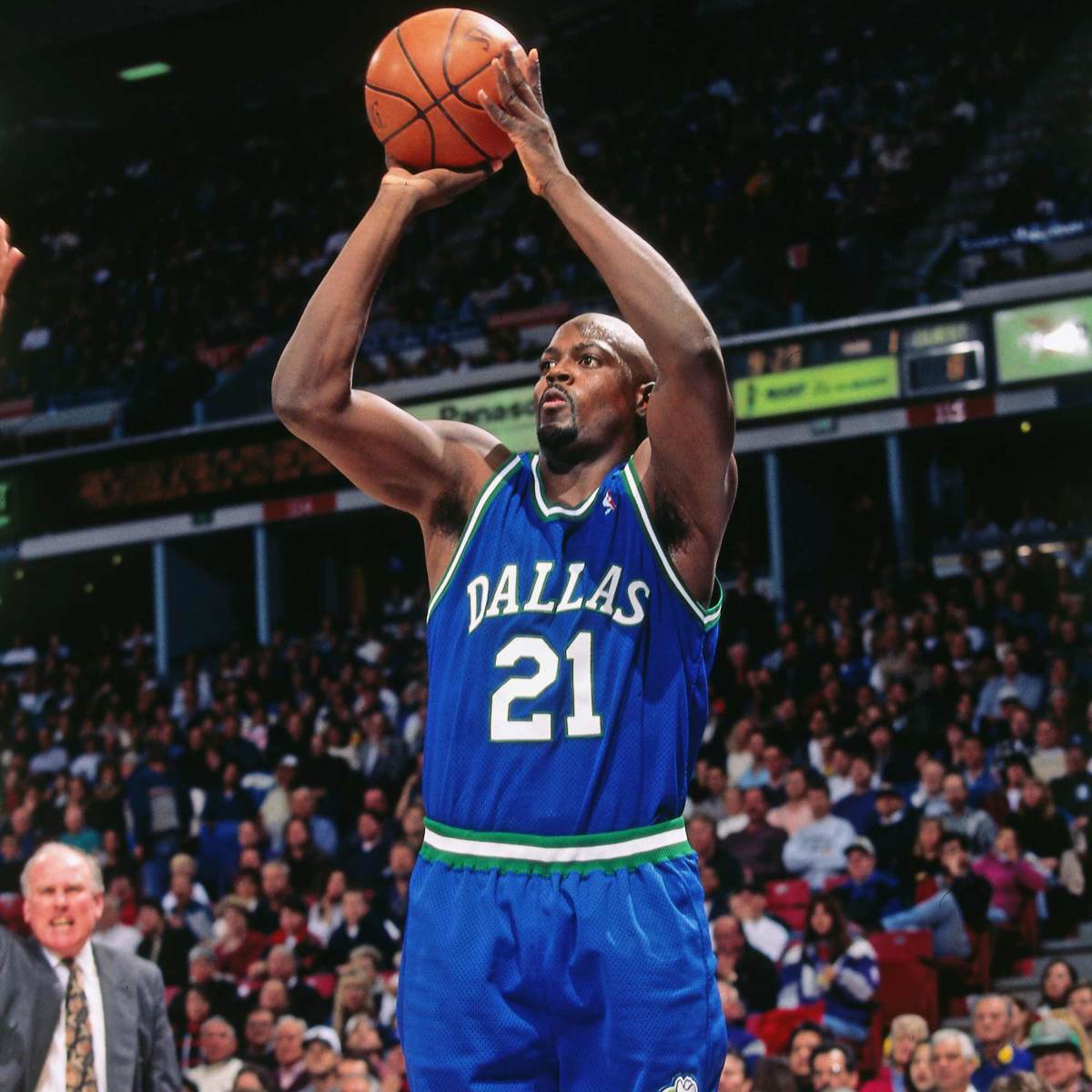The '96 Mavs: The Warriors Before The Warriors

Dick Motta saw the future. It came to him in a moment of desperation, when his Mavericks—around the midpoint of the 1995-96 season—had lost nearly their entire frontcourt to injury and calamity. Jamal Mashburn was done for the year after arthroscopic surgery. Popeye Jones was sidelined by knee tendinitis. Terry Davis could never stay healthy, Cherokee Parks was fighting back spasms, and Roy Tarpley had been banned from the league a second time for violating the terms of a court-mandated aftercare program. Any normal lineup Dallas could field would be compromised by third- or fourth-stringers at critical spots.
So out went the book. Motta was a traditionalist in the sense that he had run the same center-driven, low-post offense for decades. “Why should I change?” he asked Sports Illustrated’s Johnette Howard at the start of that season. “It works.” With these Mavs, however, it never had. And with no back-to-the-basket center (or even power forward) in sight, it seemed it never could. In the absence of that kind of centerpiece, the Mavericks flew to the opposite extreme. Motta started Jason Kidd, the best center he had left (Lorenzo Williams), and three 6'6" wings. Overnight, the Mavericks went from averaging 21.4 three-point attempts per game—a mark that essentially led the league—to routinely topping 40.
“If it was a good shooting night, that meant we were in the game,” Kidd said. “If it was a bad night, that meant we had to shoot more.”
In an eight-day span, the Mavericks tied or set the league-wide three-point shooting record on five separate occasions. The gaudiest of those records (49 attempts in a regulation win over the Nets, who took only five) stood until Mike D’Antoni’s Rockets finally eclipsed it this season. Out of necessity, a modern offense had materialized 20 years ahead of its time. "All night,” Nets center Shawn Bradley told the New York Daily News, ”we were trading them two points for three."
The strategic consensus in the mid-90s regarded three-point shooting as supplemental. It provided a means to an end; the best way to post up Hakeem Olajuwon or Shaquille O’Neal was to flank them with a marksman or two, countering the inevitable double-teams that might otherwise gum up the works. The very threat of it was meant to bring the floor to balance. Rarely was a three itself the intended result of a play’s creation…save for in Motta’s workshop. Shooters sprinted directly to the three-point line in transition. Kidd posted up smaller guards in the half-court, begging the defense to overreact. Layered sets created openings for two or three potential long-range shooters in sequence, often with the kind of hand-offs and curls emblematic of today’s best offenses.
“It was dribble-drive and kick,” said George McCloud, Dallas’s small-ball power forward. “A lot of motion—similar to the way that Golden State plays. You get a brush screen at the top, down screens, pin-downs, a lot of action from the weak side.”
Their style was jarring in its contrast. Motion itself was common to offenses around the league, most of which were heavily scripted. The Mavericks distinguished themselves through timing and distance. Players who would serve as a way station in some other plodding offense were instead told to fire away. Injured, overmatched teams don’t have the luxury of patience. They subsist on what they can actually create, and any good opening should do. “When the shots were available,” assistant coach Kip Motta said, “he always told people to shoot.” So shoot they did.

The Mavericks fancied themselves gunslingers. McCloud, who averaged more three-point shots per game than two entire NBA teams after the shift to small ball, was dubbed “The Duke.” Jim Jackson became “Wyatt Earp.” “He’s always shooting,” Williams explained to the Associated Press. Teammates called Kidd “Doc Holiday” and Lucious Harris—because “he’s so deadly”—gave way to “Clint Eastwood.” Tony Dumas, an explosive athlete, naturally went as “Billy the Kid.” “He’s young and wild,” Williams noted.
In practice, the Mavs dueled through shooting games with their per diem on the line. Anyone comfortable taking long twos, centers included, was encouraged to move back. The NBA three-point line was uniform then—as long at the top of the floor as it was in the corners—and thus all the more inviting. Teams across the league took advantage of the shift, but none in as dramatic a fashion as Dallas. Motta would prod his team nightly. If they had taken 30 threes one game, he’d tell them to aim for 35 in the next. Hit 35? Shoot for 40. Shoot 20 threes by halftime? Go for 50.
Motta had famously once instructed his center to goaltend a free throw simply because he didn’t believe that the rulebook expressly forbade it. Every edge mattered to him, and with the depths of this shooting explosion, he had stumbled into the sort of advantage that no other team in the league could stomach. Opponents hated playing against the Mavericks and yet none could bring themselves to play like them. "They just come out like gangbusters," Suns guard Kevin Johnson said, per the Associated Press. "There is no easing into the game. They press and shoot threes and fly around the court.”
“Of course,” Johnson added, “they lose when the three-pointers don't fall."
Mavericks Re-Enter NBA Playoff Race Through Careful Pacing
And often Dallas still lost even when they did. Playing small trades one mismatch for another. What the Mavericks gained in having McCloud stretch out opposing power forwards, they lost with a front line vulnerable to bludgeoning post play. “It caused matchup problems for the defense, but on our end we always had to trap and rotate,” McCloud said. Current NBA rules are more accommodating to this kind of frenzy. Defenders today can preemptively float into open space to discourage a drive or give the illusion of pressure without fully committing. In 1996, league rules demanded an all-or-nothing approach. A player could guard his own man or double another, but any lingering in the space between would incur an illegal defense penalty—a classic bit of NBA esoterica. Dallas would routinely draw three or four illegal defense calls in a single game, to say nothing of those plays in which its frontcourt was overwhelmed around the basket. Even a well-executed defense risked wearing the Mavericks down.
“Normally, we would be in the game but lose the game at the end,” McCloud said. “You're just so tired from getting back in the game by double-teaming and having to run all over the court. So we would fall short.”
Innovation comes with no guarantee of success. These Mavericks (who finished 26-56 on the season) were fundamentally weird—similar in style to teams 20 years their junior with none of the wins to show for it. The skill level, the rules, and the roster construction hadn’t caught up to the ideas in play.
The closest thing Dallas had to an equalizer was Kidd. It’s easy, in retrospect, to paper over the memory of an emerging Kidd with the vision of his later, mellower self. Kidd became a champion at 38 years old, a brilliant playmaker and versatile defender whose first step had left him long ago. Dallas relied on Kidd to steady its cause. His primary value to that team came through the smart play, the safe orchestration, and the timely shot. Kidd circa 1996, by contrast, was a force of nature. “Nobody had a quarterback like J-Kidd,” McCloud said. “No one had a 6'5", 215-pound blur. Imagine: J-Kidd was bigger than [Russell] Westbrook, taller, about 15 pounds heavier, and probably faster from end to end.”
“He showed us another dimension.”

Most everything the Mavs created that season came by Kidd’s hand. Dallas didn’t run much pick-and-roll in those days; its offense relied on Kidd to get by his defender and kick the ball out to others on the downhill. Posting Kidd was an easy fallback given that he towered over most every point guard in the league. Even at the height of the NBA’s fascination with big point guards (blame Magic Johnson), so few at the position could physically match up with Kidd. He had every advantage, including the vision to catalyze everything around him.
"I'd think if I were a player, I'd buy him a Rolex," Motta said (via the San Jose Mercury News). "That's what Emmitt Smith does for the guys who open holes for him. If I played with Jason, I'd run like hell to my best spot, knowing the ball was going to be there. He does have the ability to make the players around him better.”
It was Kidd who brought Motta’s concepts into reality—all at breakneck speed. Part of what made it possible for Dallas to shoot so many three-pointers in the first place was Kidd’s willingness to advance the ball. A quick outlet could completely change the complexion of the defense, conjuring a 4-on-3 or 3-on-2 situation from thin air. Kidd would also selectively push the pace off of an opponent’s make to create physical momentum where there was none. These Mavericks were relentless. Even after the league caught on as to where Dallas’s shooters were running, keeping up while also stopping a full-speed Kidd was a taxing, full-time commitment.
“A lot of times, teams wanted to rest on the defensive end,” McCloud said. “So when you're running up and down taking shots, they fall into trying to play fast and they're not used to playing fast. I see that all the time, even now. If you're gonna try to play like Golden State, you have to practice like Golden State.”

Dallas played so fast that it tripped up its game’s broadcasters. Fans and media tracking the score by hand were liable to miss entire runs in the quick turnaround. Any opponent who looked to get in a word, edge-wise, would be left in the dust. “They didn't have time to talk,” Kidd said. “We were going too fast. That was the beauty of it.”
From the offense sprung opportunity. The young Mavericks had been victims of ego. Jackson and Mashburn bickered over touches. Kidd’s arrival cast the team’s pecking order further into question. "You picture [the NBA], in your mind anyway, as a big step up in the maturity process," Kidd told the Dallas Morning News. "You think of the team concept prevailing with no bickering, no arguing, no internal problems. That's not reality. That would be a fantasy team."
Mashburn’s injury tabled some of that tension, though the Mavericks’ open-floor style brought some relief. The ball was flying. Any player who ran hard with Kidd could get shots, whether they were a center trying to beat their man to the rim or a shooter streaking to the corner. All three of Kidd, Jackson, and McCloud averaged 16 field goal attempts per game. “It was so much fun because you had freedom,” McCloud said. “It's not just one player that had the green light. Some games it was you, some games it wasn't you. But every game you shot. You had that opportunity.”
All-Bullseye Team: Who Faces The Most Playoff Pressure?
McCloud’s green light radiated. In the record-setting game against the Nets, he attempted 20 of the Mavericks’ 49 threes himself—a quantity topped only by J.R. Smith, Kobe Bryant, and Damon Stoudamire. Kidd drove the offense and Jackson led the team in scoring (at least in Mashburn’s absence), but McCloud was the quintessential Maverick. It was his game that stretched most when Dallas prioritized the three-point line and his utility that made small ball a practical reality. With players like McCloud well-positioned and empowered, the offense popped.
“We put up a lot of points,” Kidd said. “I don't know if we won a lot of games, but it was fun to play.”
The 1995–96 Mavericks were a team out of time. What kept them were the losses. League trends don’t follow losing clubs pushed to the brink by injury; no coach would look to the bottom of the standings for a shining example. Motta spoke to this extreme style being his expressed intention for the future of the Mavericks, yet even he went back to starting Jones once his knee allowed. Small-ball lineups became periodic. The bulk three-point shooting eventually waned to the point that Dallas was merely outpacing the league rather than lapping it. When Motta left Dallas at that season’s end by his own accord, the Mavs swung further back toward basketball convention with no lasting influence to speak of. Sometimes, anachronism is equal parts foresight and failure.
